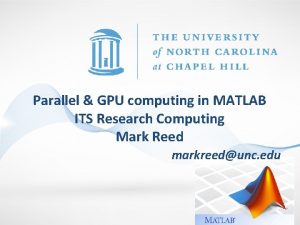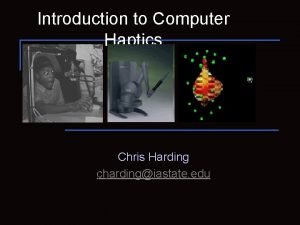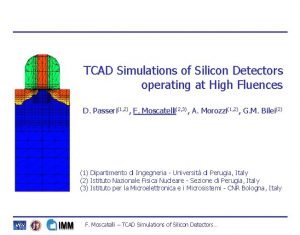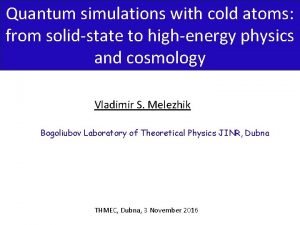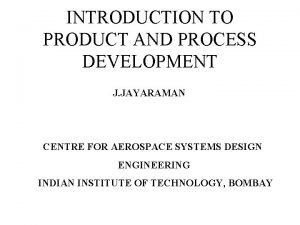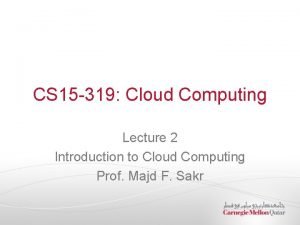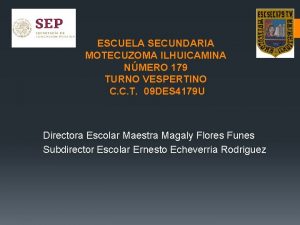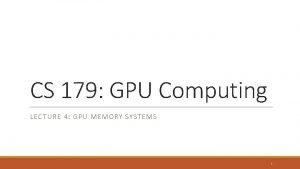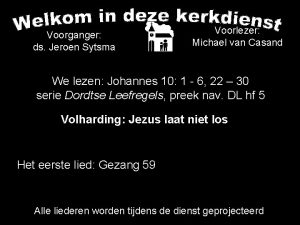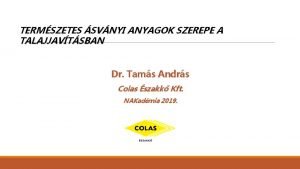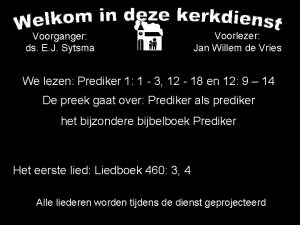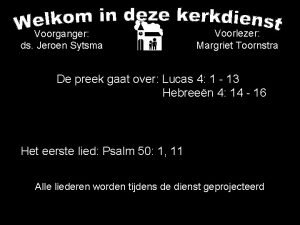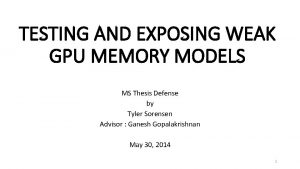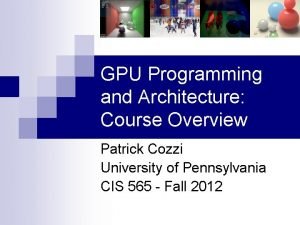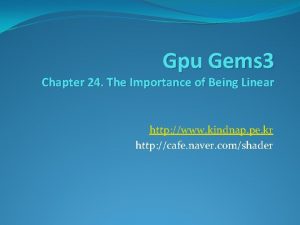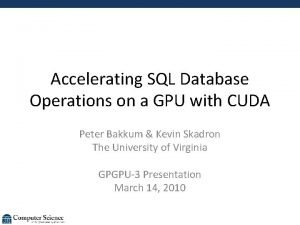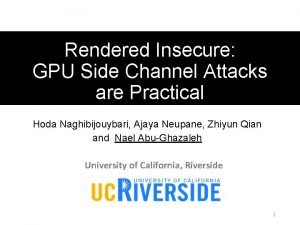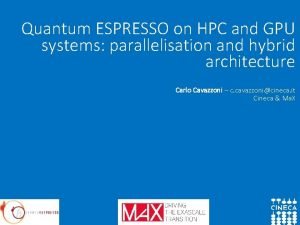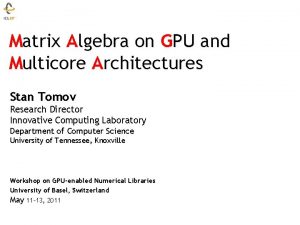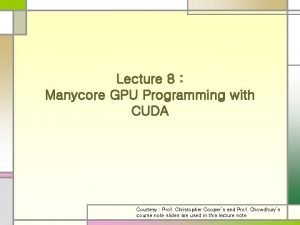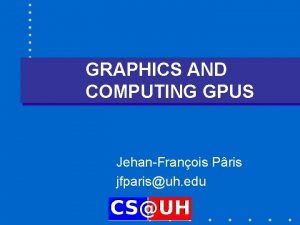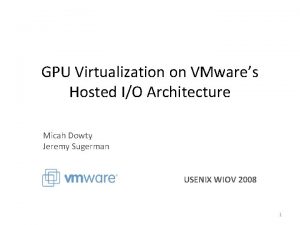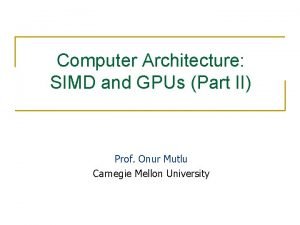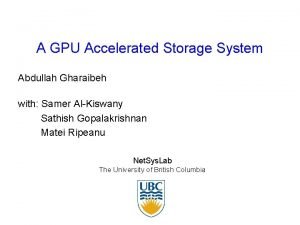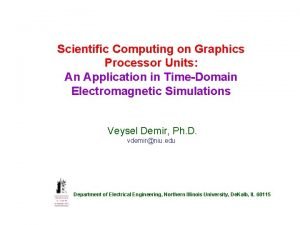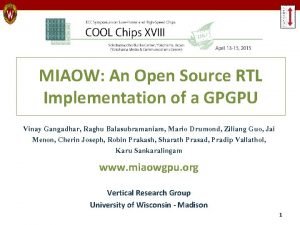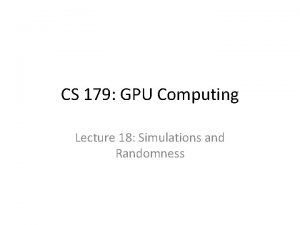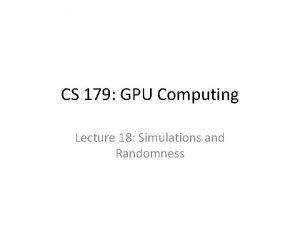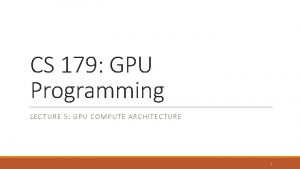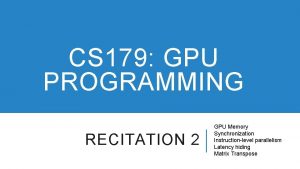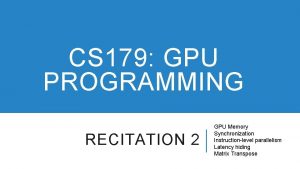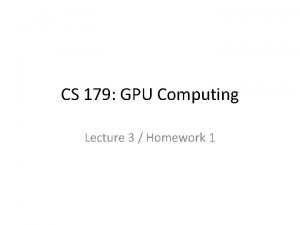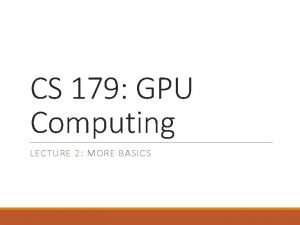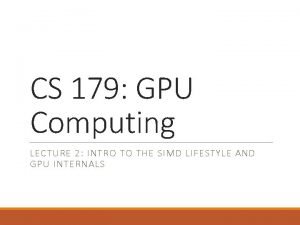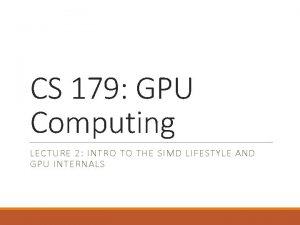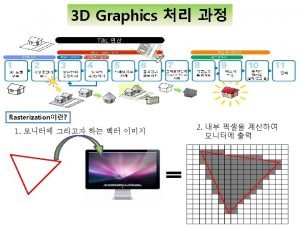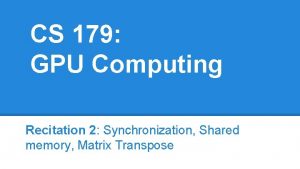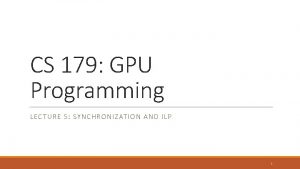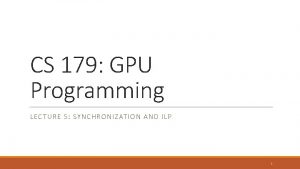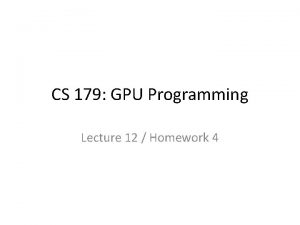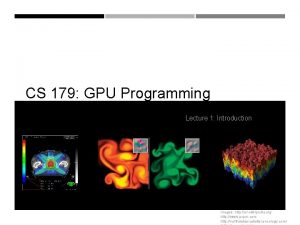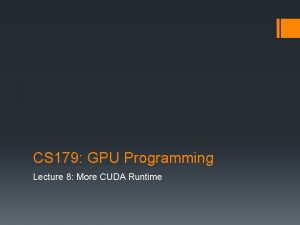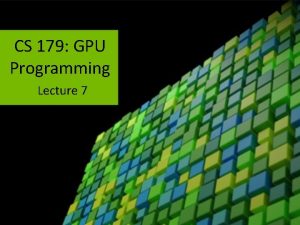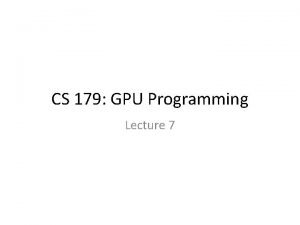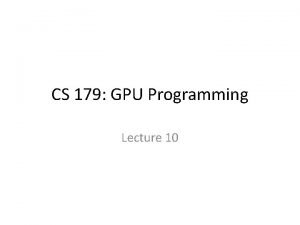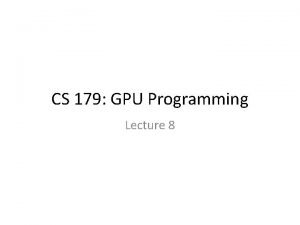CS 179 GPU Computing Lecture 16 Simulations and






















![A Very Basic PRNG • //from glibc int 32_t val = state[0]; val = A Very Basic PRNG • //from glibc int 32_t val = state[0]; val =](https://slidetodoc.com/presentation_image_h/75cfb7f61bf6b0c8e09700c103d7c648/image-23.jpg)
![A Very Basic PRNG • //from glibc int 32_t val = state[0]; val = A Very Basic PRNG • //from glibc int 32_t val = state[0]; val =](https://slidetodoc.com/presentation_image_h/75cfb7f61bf6b0c8e09700c103d7c648/image-24.jpg)





































- Slides: 61

CS 179: GPU Computing Lecture 16: Simulations and Randomness

Simulations Exa Corporation, http: //www. exa. com/images/f 16. png South Bay Simulations, http: //www. panix. com/~brosen/graphics/iacc. 400. jpg Flysurfer Kiteboarding, http: //www. flysurfer. com/wpcontent/blogs. dir/3/files/gallery/research-and-development/zwischenablage 07. jpg Max-Planck Institut, http: //www. mpagarching. mpg. de/gadget/hydrosims/

Simulations • But what if your problem is hard to solve? e. g. – EM radiation attenuation – Estimating complex probability distributions – Complicated ODEs, PDEs • (e. g. option pricing in last lecture) – Geometric problems w/o closed-form solutions • Volume of complicated shapes

Simulations • Potential solution: Monte Carlo methods – Run simulation with randomly chosen inputs • (Possibly according to some distribution) – Do it again… and again… – Aggregate results

Monte Carlo example • Estimating the value of π

Monte Carlo example • Estimating the value of π – Quarter-circle of radius r: • Area = (πr 2)/4 – Enclosing square: • Area = r 2 – Fraction of area: π/4 "Pi 30 K" by Caitlin. Jo - Own work. This mathematical image was created with Mathematica. Licensed under CC BY 3. 0 via Wikimedia Commons - http: //commons. wikimedia. org/wiki/File: Pi_30 K. gif#/media/File: Pi_30 K. gif

Monte Carlo example • Estimating the value of π – Quarter-circle of radius r: • Area = (πr 2)/4 – Enclosing square: • Area = r 2 – Fraction of area: π/4 ≈ 0. 79 • “Solution”: Randomly generate lots of points, calculate fraction within circle – Answer should be pretty close! "Pi 30 K" by Caitlin. Jo - Own work. This mathematical image was created with Mathematica. Licensed under CC BY 3. 0 via Wikimedia Commons - http: //commons. wikimedia. org/wiki/File: Pi_30 K. gif#/media/File: Pi_30 K. gif

Monte Carlo example • Pseudocode: (simulate on N points) (assume r = 1) points_in_circle = 0 for i = 0, …, N-1: randomly pick point (x, y) from uniform distribution in [0, 1] 2 if (x, y) is in circle: points_in_circle++ return (points_in_circle / N) * 4 "Pi 30 K" by Caitlin. Jo - Own work. This mathematical image was created with Mathematica. Licensed under CC BY 3. 0 via Wikimedia Commons - http: //commons. wikimedia. org/wiki/File: Pi_30 K. gif#/media/File: Pi_30 K. gif

Monte Carlo example • Pseudocode: (simulate on N points) (assume r = 1) points_in_circle = 0 for i = 0, …, N-1: randomly pick point (x, y) from uniform distribution in [0, 1] 2 if x^2 + y^2 < 1: points_in_circle++ return (points_in_circle / N) * 4 "Pi 30 K" by Caitlin. Jo - Own work. This mathematical image was created with Mathematica. Licensed under CC BY 3. 0 via Wikimedia Commons - http: //commons. wikimedia. org/wiki/File: Pi_30 K. gif#/media/File: Pi_30 K. gif

Monte Carlo simulations Planetary Materials Microanalysis Facility, , Northern Arizona University, http: //www 4. nau. edu/microanalysis/microprobesem/Images/Monte_Carlo. jpg Center for Air Pollution Impact & Trend Analysis, Washington University in St. Louis, http: //www 4. nau. edu/microanalysis/microprobesem/Images/Monte_Carlo. jpg http: //www. cancernetwork. com/sites/default/files/cn_import/n 0011 bf 1. jpg

General Monte Carlo method • Pseudocode: for (number of trials): randomly pick value from a probability distribution perform deterministic computation on inputs (aggregate results)

General Monte Carlo method • Why it works: – Law of large numbers!

General Monte Carlo method • Pseudocode: for (number of trials): randomly pick value from a probability distribution perform deterministic computation on inputs (aggregate results) • Can we parallelize this?

General Monte Carlo method • Pseudocode: for (number of trials): randomly pick value from a probability distribution perform deterministic computation on inputs (aggregate results) • Can we parallelize this? Trials are independent

General Monte Carlo method • Pseudocode: for (number of trials): randomly pick value from a probability distribution perform deterministic computation on inputs (aggregate results) Usually so (e. g. with reduction) • Can we parallelize this? Trials are independent

General Monte Carlo method • Pseudocode: for (number of trials): randomly pick value from a probability distribution perform deterministic computation on inputs (aggregate results) Usually so (e. g. with reduction) • Can we parallelize this? What about this? Trials are independent

Parallelized Random Number Generation

Early Credits • Algorithm and presentation based on: – “Parallel Random Numbers: As Easy as 1, 2, 3” • (Salmon, Moraes, Dror, Shaw) at D. E. Shaw Research • Developed for biomolecular simulations on Anton (massively parallel ASIC-based supercomputer) • Also applicable to CPUs, GPUs

Random Number Generation • Generating random data computationally is hard – Computers are deterministic! https: //cdn. tutsplus. com/vector/uploads/legacy/tuts/165_Shiny_Dice/27. jpg

Random Number Generation • Two methods: – Hardware random number generator • aka TRNG (“True” RNG) • Uses data collected from environment (thermal, optical, etc) • Very slow! – Pseudorandom number generator (PRNG) • Algorithm that produces “random-looking” numbers • Faster – limited by computational power

Demonstration

Random Number Generation • PRNG algorithm should be: – High-quality • Produce “good” random data – Fast • (In its own right) – Parallelizable! • Can we do it? – (Assume selection from uniform distribution)
![A Very Basic PRNG from glibc int 32t val state0 val A Very Basic PRNG • //from glibc int 32_t val = state[0]; val =](https://slidetodoc.com/presentation_image_h/75cfb7f61bf6b0c8e09700c103d7c648/image-23.jpg)
A Very Basic PRNG • //from glibc int 32_t val = state[0]; val = ((state[0] * 1103515245) + 12345) & 0 x 7 fffffff; state[0] = val; *result = val;
![A Very Basic PRNG from glibc int 32t val state0 val A Very Basic PRNG • //from glibc int 32_t val = state[0]; val =](https://slidetodoc.com/presentation_image_h/75cfb7f61bf6b0c8e09700c103d7c648/image-24.jpg)
A Very Basic PRNG • //from glibc int 32_t val = state[0]; val = ((state[0] * 1103515245) + 12345) & 0 x 7 fffffff; state[0] = val; *result = val; Non-parallelizable recurrence relation!

Linear congruential generators • "Lcg 3 d". Licensed under CC BY-SA 3. 0 via Wikimedia Commons - http: //commons. wikimedia. org/wiki/File: Lcg_3 d. gif#/media/File: Lcg_3 d. gif

Measures of RNG quality • Impossible to prove a sequence is “random” • Possible tests: – Frequency – Periodicity - do the values repeat too early? – Linear dependence –…

PRNG Parallelizability •

PRNG Parallelizability •

PRNG Parallelizability •

PRNG Parallelizability •

More General PRNG •

More General PRNG • If S has J times more bits than U, can produce J outputs per transition. Assume J = 1 in this lecture

More General PRNG •

More General PRNG •

More General PRNG •

More General PRNG •

More General PRNG •

More General PRNG • i. e. what if we had: – Simple transition function f – Complicated output function g(k, n) • Should be bijective w/r/to n – Guarantees period of 2 p • Shouldn’t be too difficult to compute

Bijective Functions • Cryptographic block ciphers! – AES (Advanced Encryption Standard), Threefish, … – Must be bijective! • (Otherwise messages can’t be encrypted/decrypted)

AES-128 Algorithm • 1) Key Expansion – Determine all keys k from initial cipher key k. B • Used to strengthen weak keys Sohaib Majzoub and Hassan Diab, Reconfigurable Systems for Cryptography and Multimedia Applications, http: //www. intechopen. com/source/html/38442/me dia/image 19_w. jpg

AES-128 Algorithm • 2) Add round key – Bitwise XOR state s with key k 0 By User: Matt Crypto - Own work. Licensed under Public Domain via Wikimedia Commons - http: //commons. wikimedia. org/wiki/File: AESAdd. Round. Key. svg#/media/File: AES-Add. Round. Key. svg

AES-128 Algorithm • 3) For each round… (10 rounds total) – a) Substitute bytes • Use lookup table to switch positions By User: Matt Crypto - Own work. Licensed under Public Domain via Wikimedia Commons - http: //commons. wikimedia. org/wiki/File: AESAdd. Round. Key. svg#/media/File: AES-Add. Round. Key. svg

AES-128 Algorithm • 3) For each round… – b) Shift rows By User: Matt Crypto - Own work. Licensed under Public Domain via Wikimedia Commons - http: //commons. wikimedia. org/wiki/File: AESAdd. Round. Key. svg#/media/File: AES-Add. Round. Key. svg

AES-128 Algorithm • 3) For each round… – c) Mix columns • Multiply by constant matrix By User: Matt Crypto - Own work. Licensed under Public Domain via Wikimedia Commons - http: //commons. wikimedia. org/wiki/File: AESAdd. Round. Key. svg#/media/File: AES-Add. Round. Key. svg

AES-128 Algorithm • 3) For each round… – d) Add round key (as before) By User: Matt Crypto - Own work. Licensed under Public Domain via Wikimedia Commons - http: //commons. wikimedia. org/wiki/File: AESAdd. Round. Key. svg#/media/File: AES-Add. Round. Key. svg

AES-128 Algorithm • 4) Final round – Do everything in normal round except mix columns

AES-128 Algorithm • Summary: – 1) Expand keys – 2) Add round key – 3) For each round (10 rounds total) • • Substitute bytes Shift rows Mix columns Add round key – 4) Final round: • (do everything except mix columns)

Algorithmic Improvements • We have a good PRNG! – Simple transition function f • Counter – Complicated output function g(k, n) • AES-128

Algorithmic Improvements • We have a good PRNG! – Simple transition function f • Counter – Complicated output function g(k, n) • AES-128 – High quality! • Passes Crush test suite (more on that later) – Parallelizable! • f and g only depend on k, n ! – Sort of slow to compute • AES is sort of slow without special instructions (which GPUs don’t have)

Algorithmic Improvements • Can we “make AES go faster”? – AES is a cryptographic algorithm, but we’re using it for PRNG – Can we change the algorithm for our purposes?

AES-128 Algorithm • Summary: – 1) Expand keys – 2) Add round key – 3) For each round (10 rounds total) • • Substitute bytes Shift rows Mix columns Add round key – 4) Final round: • (do everything except mix columns)

AES-128 Algorithm • Summary: Purpose of this step is to hide key from attacker using chosen plaintext. Not relevant here. – 1) Expand keys – 2) Add round key – 3) For each round (10 rounds total) • • Substitute bytes Shift rows Mix columns Add round key – 4) Final round: • (do everything except mix columns)

AES-128 Algorithm • Summary: Purpose of this step is to hide key from attacker using chosen plaintext. Not relevant here. – 1) Expand keys – 2) Add round key – 3) For each round (10 rounds total) • • Substitute bytes Shift rows Mix columns Add round key Do we really need this many rounds? – 4) Final round: • (do everything except mix columns) Other changes?

Key Schedule Change • Old key schedule: – – – The first n bytes of the expanded key are simply the encryption key. The rcon iteration value i is set to 1 Until we have b bytes of expanded key, we do the following to generate n more bytes of expanded key: • We do the following to create 4 bytes of expanded key: – – – • We then do the following three times to create the next twelve bytes of expanded key: – – • We create a 4 -byte temporary variable, t We assign the value of the previous four bytes in the expanded key to t We perform the key schedule core (see above) on t, with i as the rcon iteration value We increment i by 1 We exclusive-OR t with the four-byte block n bytes before the new expanded key. This becomes the next 4 bytes in the expanded key We assign the value of the previous 4 bytes in the expanded key to t We exclusive-OR t with the four-byte block n bytes before the new expanded key. This becomes the next 4 bytes in the expanded key If we are processing a 256 -bit key, we do the following to generate the next 4 bytes of expanded key: – – – We assign the value of the previous 4 bytes in the expanded key to t We run each of the 4 bytes in t through Rijndael's S-box We exclusive-OR t with the 4 -byte block n bytes before the new expanded key. This becomes the next 4 bytes in the expanded key. Copied from Wikipedia (Rijndael Key Schedule) • New key schedule: – k 0 = k. B – ki+1 = ki + constant • e. g. golden ratio

AES-128 Algorithm • Summary: – 1) Expand keys using simplified algorithm – 2) Add round key – 3) For each round (10 5 rounds total) • • Substitute bytes Shift rows Mix columns Add round key – 4) Final round: • (do everything except mix columns) Other simplifications possible!

Algorithmic Improvements • We have a good PRNG! – Simple transition function f • Counter – Complicated output function g(k, n) • Modified AES-128 (known as ARS-5) – High quality! • Passes Crush test suite (more on that later) – Parallelizable! • f and g only depend on k, n ! – Moderately faster to compute

Even faster parallel PRNGs • Use a different g, e. g. – Threefish cipher • Optimized for PRNG – known as “Threefry” – “Philox” • (see paper for details) • 202 GB/s on GTX 580! – Fastest known PRNG in existence

General Monte Carlo method • Pseudocode: for (number of trials): randomly pick value from a probability distribution perform deterministic computation on inputs (aggregate results) Usually so (e. g. with reduction) • Can we parallelize this? What about this? Trials are independent

General Monte Carlo method • Pseudocode: for (number of trials): randomly pick value from a probability distribution perform deterministic computation on inputs (aggregate results) Usually so (e. g. with reduction) • Can we parallelize this? – Yes! – Part of cu. RAND Yes! Trials are independent

Summary • Monte Carlo methods – Very useful in scientific simulations – Parallelizable because of… • Parallelized random number generation – Another story of “parallel algorithm analysis”

Credits (again) • Parallel RNG algorithm and presentation based on: – “Parallel Random Numbers: As Easy as 1, 2, 3” • (Salmon, Moraes, Dror, Shaw) at D. E. Shaw Research
 Gpgpu matlab
Gpgpu matlab Best gpu for scientific computing
Best gpu for scientific computing Parallel and distributed computing lecture notes
Parallel and distributed computing lecture notes 01:640:244 lecture notes - lecture 15: plat, idah, farad
01:640:244 lecture notes - lecture 15: plat, idah, farad Yes or no
Yes or no Clinical simulations in nursing education
Clinical simulations in nursing education Chris harding simulations
Chris harding simulations Tcad simulations
Tcad simulations World history simulations
World history simulations Simulations for solid state physics
Simulations for solid state physics Payroll card
Payroll card Pinpoint simulations 777
Pinpoint simulations 777 Baton simulations
Baton simulations Conventional computing and intelligent computing
Conventional computing and intelligent computing Cloud computing cmu
Cloud computing cmu Gezang 179
Gezang 179 Contoh anugerah allah
Contoh anugerah allah Gezang 179
Gezang 179 Jhs 179
Jhs 179 Himno 179
Himno 179 Norm 1125
Norm 1125 Motecuzoma ilhuicamina 179
Motecuzoma ilhuicamina 179 Tactical intelligence ground station
Tactical intelligence ground station Hw-179
Hw-179 Gezang 179
Gezang 179 Cs 179
Cs 179 Jeroen sytsma
Jeroen sytsma Gezang 179
Gezang 179 4.1 minidialogues asl
4.1 minidialogues asl 791-179-455
791-179-455 0-179 altitude
0-179 altitude Gezang 179
Gezang 179 Jhs 179
Jhs 179 Gezang 179
Gezang 179 Hazmat material table
Hazmat material table Gezang 179
Gezang 179 Gezang 179
Gezang 179 Jhs 179
Jhs 179 Gpu memory test
Gpu memory test Vulkan optimization
Vulkan optimization Gpu ocelot
Gpu ocelot Grafikkarte funktionsweise
Grafikkarte funktionsweise Githubn
Githubn Gpu gems 4
Gpu gems 4 Gpu acceleration matlab
Gpu acceleration matlab Cache coherence for gpu architectures
Cache coherence for gpu architectures Gpu sql database
Gpu sql database Fpga gpu comparison
Fpga gpu comparison Rendered insecure: gpu side channel attacks are practical
Rendered insecure: gpu side channel attacks are practical Quantum espresso gpu installation
Quantum espresso gpu installation Gpu perfstudio
Gpu perfstudio Matrix multiplication stan
Matrix multiplication stan Gpu
Gpu Gpu pris
Gpu pris Vmware workstation 16 gpu passthrough
Vmware workstation 16 gpu passthrough Simd vs gpu
Simd vs gpu Gpu accelerated storage
Gpu accelerated storage Cpu vs gpu
Cpu vs gpu Kvm gpu acceleration
Kvm gpu acceleration Adobe certified gpu
Adobe certified gpu Miaow gpu
Miaow gpu Hortonworks gpu
Hortonworks gpu
